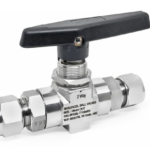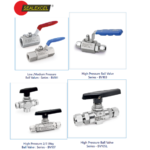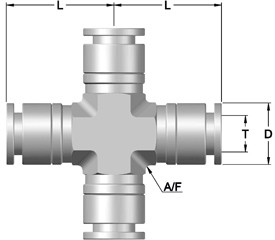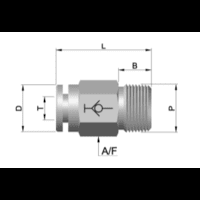
The Ultimate Guide to Ball Valve: How They Work and When to Use Them
September 18, 2023
Ball Valve Types: A Comprehensive Guide to 4 Types of Ball Valves
November 20, 2023Coupling pipe fittings play a crucial role in plumbing, irrigation, and various piping systems. These simple yet indispensable components are the unsung heroes of many infrastructure projects, ensuring that fluids and gases flow smoothly and securely from one point to another. This blog will dive deep into discussing their types, applications, installation procedures, and much more. By the end, you’ll comprehensively understand Coupling Pipe fittings and their significance in various industries.
What Are Coupling Pipe Fittings?
At its core, a coupling pipe fitting is a device used to connect two pipes. These fittings come in various shapes, sizes, and materials, each designed to meet specific requirements. The primary purpose of coupling pipes is to create a secure and leak-free connection between two pipes while allowing for easy disconnection. This versatility makes coupling pipe fittings essential in a wide range of applications.
Types of Coupling Pipe Fittings
- Rigid Couplings: Rigid fittings are solid and non-flexible connectors. They are commonly used when pipe alignment is critical and pipes cannot move independently.
- Flexible Couplings: These are designed to allow a slight movement between the connected pipes. They are often used to compensate for misalignment or to absorb vibration and shock in the system.
- Compression Couplings: Compression coupling pipe fittings consist of two separate parts that compress together to form a watertight seal. They are typically used in plumbing systems and are relatively easy to install.
- Mechanical Couplings: Mechanical coupling pipes utilize gaskets and fasteners to create a tight seal. They are commonly found in industrial applications and large-diameter piping systems.
- Flanged Couplings: Flanged coupling pipe fittings are used when pipes need to be easily disassembled for maintenance. They involve bolts and flanges to create a strong connection.
- Grooved Couplings: Grooved coupling pipe fittings feature a groove in both pipe ends that connects with a rubber gasket and two housings. They are quick to install and are often used in firefighting and HVAC systems.
- Threaded Couplings: Threaded coupling pipes are connected by screwing the threaded ends of pipes together. They are common in small-diameter pipes and are straightforward to assemble.
Applications of Coupling Pipe Fittings
- Plumbing Systems : In residential and commercial plumbing, coupling pipes are essential for connecting water and sewage pipes. They are used to create leak-free joints between different pipe materials, ensuring the smooth flow of water throughout the building.
2 . Industrial Piping : Large industrial facilities often use mechanical and flanged coupling pipes to connect pipes in complex systems. These fittings provide a strong and reliable connection for transporting various substances, including chemicals, oil, and gases.
- Irrigation : In agricultural and landscaping applications, coupling pipes connect sections of irrigation pipes. Flexible and grooved are often preferred, as they can accommodate the movement of the soil and pipes due to environmental factors.
- HVAC Systems :Heating, ventilation, and air conditioning (HVAC) systems connect air ducts and pipes using coupling pipes. These connections help maintain the system’s integrity and ensure efficient temperature control.
- Fire Protection : Grooved and threaded coupling pipes are crucial in fire protection systems, where assembling and disassembling pipes quickly is essential. These fittings ensure that water flows efficiently through the fire sprinkler network when needed.
- Oil and Gas Industry : The oil and gas industry extensively uses coupling pipes to transport petroleum and natural gas. Rigid and compression coupling pipe fittings are commonly employed to maintain the structural integrity of pipelines.
Installation of Coupling Pipe Fittings
Installing is a straightforward process, but it does require some basic knowledge and tools. Here are the general steps for installing coupling pipe fittings:
- Prepare the Pipes: Ensure that the pipe ends are clean, debris-free, and cut squarely to achieve a proper fit.
- Select the Right Coupling: Choose the appropriate coupling pipe fitting for your application, considering factors like pipe material, size, and the type of connection needed.
- Assemble the Fitting: If it’s a compression, mechanical, or flanged coupling, assemble the fitting with the gaskets and fasteners per the manufacturer’s instructions.
- Connect the Pipes: Slide the coupling over one pipe end, align it with the other pipe, and tighten any fasteners or threads as necessary to create a secure connection.
- Test for Leaks: Perform a pressure test to ensure no leaks. If leaks are detected, recheck the assembly and make any necessary adjustments.
- Secure and Support: Once the coupling pipe fitting is properly installed, secure it using hangers, clamps, or other support systems, especially in vertical applications.
Advantages of Coupling Pipe Fittings
Coupling pipes offer several advantages, making them a preferred choice in various industries:
- Ease of Installation: Coupling pipe fittings are relatively easy to install, saving time and labour costs.
- Leak Prevention: When installed correctly, coupling pipes create leak-free connections, ensuring the system’s integrity.
- Versatility: With various types available, coupling pipes can adapt to different pipe materials and applications.
- Maintenance and Repairs: Coupling pipes facilitate easy access to pipes for maintenance or repairs without replacing an entire section.
- Shock Absorption: Flexible coupling pipes absorb vibration and shock, reducing stress on the piping system.
- Dismantling: Flanged and grooved coupling pipes allow for easy disassembly, making repairs or modifications straightforward.
Conclusion
In piping and plumbing, coupling pipe fittings are the unsung heroes that keep our systems functioning smoothly. Whether it’s plumbing, industrial processes, or irrigation, coupling pipes play a crucial role in ensuring the efficient flow of fluids and gases. By understanding the basics of coupling fittings, you’re better equipped to select the right fittings for your specific application and to maintain the integrity of your piping systems. These seemingly simple components are the backbone of many industries, ensuring that everything flows as it should.



